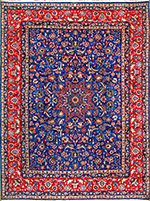Textiles Studies

Textile Research Works
Date of this Version
2004
Document Type
Article
Citation
Ghereh (Turin, Italy) (2004), pp. 9-15.
Abstract
Two recent exhibitions, Carpets of Andalusia and Mamluk Rugs from Egypt, at The Textile Museum afforded a rare opportunity to compare two radically different rug-weaving traditions from the perspectives of design and weave structure. While not often evident to the casual viewer, there is a significant relationship between design, pattern, and weave structure in all Oriental carpets. The opportunity to explore such differences warrants careful examination and critical viewing.
The Mamluk rugs all probably date from the last quarter of the 15th century. They comprise a cohesive group defined by color, a geometric style, and similarity of weave characteristics. The range of colors is limited to reds, blues, and greens, with the occasional addition of yellow, white, or brown for outlines and highlights (p.10). ...
In contrast, the Spanish rugs, although representing a great diversity of cultural traditions, share a unique knot structure that utilizes single warps – unlike those of any other wellknown rug-weaving tradition. The single-warp knot is so typical of Spanish carpets that it has become known as the “Spanish knot”. This type of knot, and its offset placement on a set of warps, is particularly significant in relation to characteristics of design.
Included in
Art and Materials Conservation Commons, Art Practice Commons, Fiber, Textile, and Weaving Arts Commons, Indigenous Studies Commons, Museum Studies Commons

